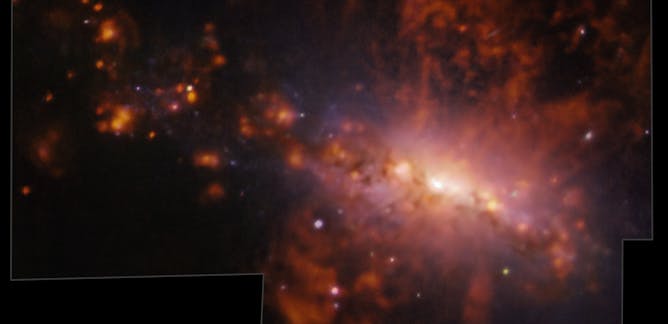
Articles on Star formation
Displaying 1 - 20 of 32 articles

When astronomers focused on the galaxy NGC 4383, they didn’t expect the data to be so spectacular. This is the first detailed map of gas flowing from this galaxy as stars burst within.

Analysis of fragments of the first solids that emerged out of the birth of the sun date our supernova as being 4.6 billion years old.

An attempt to study gas in one galaxy with the MeerKAT radio telescope detected 49 other galaxies instead.

One of the few examples of a fast radio burst and the slow-moving, star forming gas in its origin galaxy has been linked together – thanks to observations from a CSIRO telescope.

Astronomers have long known where water is first formed in the universe and how it ends up on planets, asteroids and comets. A recent discovery has finally answered what happens in between.

An astronomer takes us on a tour of the universe to learn about the birth of stars and planets and how they get their spin.

We may have a stolen planet in our own Solar System.

Studying the extreme environment of the Virgo Cluster — which comprises thousands of galaxies — helps us learn what factors can affect and start or stop star formation.

Gravitational waves reveal the demise of super-dense neutron stars spiralling into their black hole companions - the first time such strange and exotic star systems have ever been observed.

Thirty years ago the Hubble Space Telescope began snapping photos of distant stars, providing a time machine that has taken astronomers back to when the universe was less than a billion years old.

Why isn’t there an endless variety of planets in the universe? An astrophysicist explains why planets only come in two flavors.

Astronomers have indirectly spotted some of the first stars in the universe by making their most distant detection of oxygen in a galaxy that existed just 500m years after the Big Bang.

A three-dimensional look and listen at a dark cloud in space sheds new light on the mystery of how our solar system formed billions of years ago.

As galaxies get older they get rounder, and fall victim to the middle-aged spread that catches many of us humans here on Earth.

Massive, far distant galaxies contain 100 times more gas than we thought possible.

The science of red skies can also help us understand how stars form.

It’s like one great big distillery up there.

Astronomers are surprised by what they’re finding out about galaxies that formed in the early days of our universe, now that sensitive telescopes allow direct observation, not the inference of old.

Understanding how the billions of stars in our galaxy formed and evolved is the subject of a huge galactic archaeology project.

Galaxies are supposed to be the place where new stars are formed. So what causes some to stop this stellar production line?
